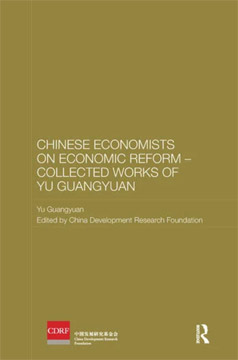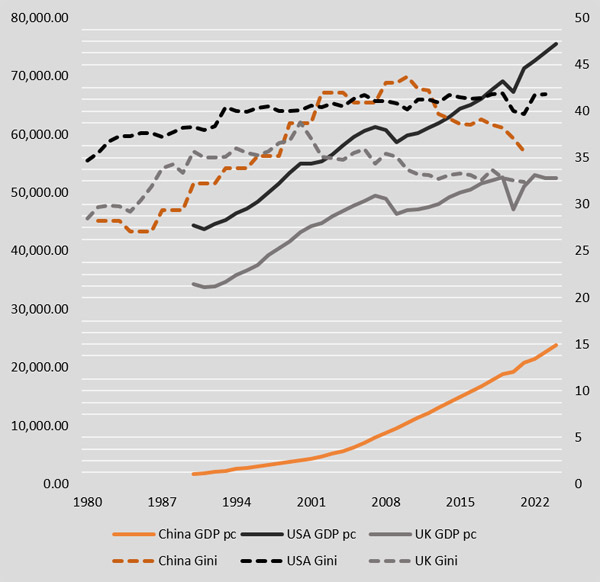
Economic commentary:
YU GUANGYUAN
Deng Xiaoping, leader of China from 1978 to 1989, is known as the “Architect of Modern China” due to the fact that his reforms laid the foundation for the economic rise of modern China. During this period, Yu Guangyuan was the head of the Political Research Office of the State Council, the first director of the Economic Research Institute of the State Planning Commission, the vice president of the Chinese Academy of Social Sciences and the director of the academy’s Marxist Research Institute.
He was, in other words, the leading economist during Deng Xiaoping. Amongst other, Yi Guangyuan is credited with drafting Deng’s landmark 1978 speech “Liberate Thought, Seek Truth from Facts and Unite to Look Forward” at the Third Plenary Session of the 11th Central Committee of the Communist Party of China, which marked the start of China’s economic reforms. It was a time when the Party officially shifted from Mao Zedong’s emphasis on class struggle to Deng Xiaoping’s reform and opening-up policy.
About the economic reform in China
The book “Chinese Economists on Economic Reform – Collected Works of Yu Guangyuan” is part of a Routledge series called Routledge Studies on the Chinese Economy. It presents a collection of texts on the considerations of what the Four Modernizations should be based on, so that China could become a great socialist country by the end of the 20th century, i.e., a country that increases production based on high tech in order to improve the living standards of its population. Raising the living standard of the population is the ultimate goal of the reform processes.
Guangyuan writes that Marx and Engels clearly stated that socialism would replace capitalism, but they provided limited descriptions of what a future socialist society should look like. Remaining faithful to Marxist theory of socialism, while also studying the positive and negative experiences of other socialist and capitalist countries, Guangyuan believed it is necessary to keep China’s realities in mind when formulating plans for essential reforms. To this end, Guangyuan highlights Yugoslavia, Romania and Hungary as examples of successful socialist countries. In 1978 and 1979, he joined Chinese delegations to study the economic and social systems of these countries.
Yugoslavia was the first socialist country to abandon the Soviet model of development and the Chinese delegation, during a three-week stay, was fascinated by the speed of construction, such as the reconstruction of Skopje after the earthquake or the new part of Belgrade (especially when compared to the fact that the construction of a metro line in Beijing at that time took 8 years and was still not completed).
Hungary left a positive impression on the Chinese delegation as well, particularly its approach to economic reforms, which was thoroughly studied and planned over three years before being launched in 1966. From this, it could be concluded, how important it is to prepare the foundations for long-term reforms based on solid principles, while maintaining a certain flexibility due to changing domestic and international conditions. The famous saying attributed to Deng Xiaoping: “It doesn’t matter whether a cat is black or white, as long as it catches mice” sums up the pragmatic approach to economic reforms.
Guangyuan argued that it is necessary to build a socialist economic framework guided by the principles of dialectical and historical materialism (in particular, the law of negation of the negation). Here we find that Marxism, as a science, is at the basis of building socialism. The path to socialism requires flexibility, constant adaptations and reforms, in order to resolve the contradictions arising from the material conditions on the ground. The historical task is to evolve toward socialism by developing the economy and productive forces, addressing all contradictions encountered along this long journey.
According to the isohyet, China can be divided into two parts, the developed southeast, where 94% of the population lives, and the less developed northwest, where 6% lives. The southeast, encompassing the coastal areas, led in implementing the Four Modernizations, advancing new technologies and science, while the northwest consists of arid and semi-arid regions. However, the author opposed protecting less developed regions, advocating instead for their openness to domestic competition while maintaining unity toward other countries. Even less developed regions have economic potential, Guangyuan argued, citing a Chinese proverb that even a small sparrow possesses all its internal organs.
The primary stage of socialism in China only began in 1956, when the transformation of the private sector into socialist public ownership was completed. Over the following two decades, the economy of the public ownership grew so strong that coexistence with non-public (capitalist and individual) sectors was openly supported, provided that public ownership remained the mainstay. Guangyuan explains the rationale (p. 100): “Take the sufficient employment of urban residents as an example. Currently, in the public sector the government has to invest more than RMB 10,000 on average to provide job opportunities, while it invests nothing in the individual economy; then it can spend more on key projects, so as to better promote the development of the public sector”.
Moreover, in the primary stage of socialism, due to distribution according to work, it is perfectly fine to allow some people to get rich first (p. 102): “In such a specific stage, the aim of allowing some to get rich first is to encourage and help others to follow suit so as to achieve common prosperity. Therefore, such an idea is not contradictory to the goal of common prosperity, and is an important means to realize it. When we put this idea into practice, it is necessary to correctly handle its relationship with the common prosperity for the whole society, so as to avoid a wide rich-poor divide as seen in a society with private ownership”.
He emphasized that China needs to understand the law of the latecomer´s benefit (p. 104): “Since leading countries have no experience to draw on, they have to grope their way to a large extent and may take a roundabout course and even do something stupid. But their followers can follow an easier route if they learn carefully from their forerunners, although they may still need to explore many uncertain areas and make the same mistakes of their forerunners. Much more time and effort should be spent on the discovery of new natural science and the creation of new technologies than on learning them”.
Some brief comparisons
Guangyuan emphasized that raising the living standard of the population is the ultimate goal of the reform processes, although some might get rich first. The chart on this website displays data for the two relevant variables from 1980 to 2024 for China, the USA and the UK. Before analyzing the chart, a brief explanation of the two variables:
• (left hand scale) GDP per capita, PPP (constant 2021 international $) represents the average income per person, adjusted for inflation and local cost of living, enabling a true comparison of living standards across countries and over time.
• (right hand scale) The Gini index measures income inequality within a nation. A value of 0 indicates perfect equality (everyone has the same income), while a value of 100 indicates perfect inequality (one person has all the income). Generally, a value above 40 signals high inequality.
The data reveals that while all three countries grew wealthier, they followed different paths. China achieved the substantial rise in living standards, though initially with high inequality that has recently begun to decrease. The USA saw strong growth in average living standards, but it was accompanied by persistently high inequality. The UK balanced the two, achieving significant growth in living standards while maintaining lower inequality than the USA.
Therefore, the data shows a convergence in average living standards towards those of developed nations like the UK and USA, which was a central aim of the “reform and opening-up” policy. However, as the mission was not solely about raising the average standard but the general standard, the rise in the Gini coefficient shows that the benefits of growth were not evenly distributed for a long time. The recent downward trend in China’s Gini index (from a peak of 43.7 in 2010 to 35.7 in 2021) indicates the policy is evolving to address these deliberately allowed inequality effects.
Living standards and income inequality in China, USA and UK (1980–2024)

Note: GDP per capita PPP, constant 2021 international $ (left hand scale) and the Gini index (right hand scale).
Source: World Development Indicators.


